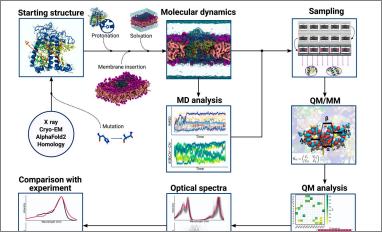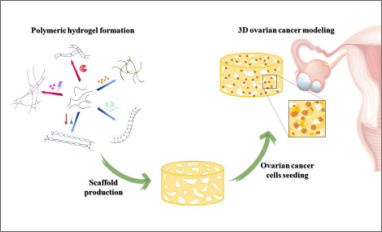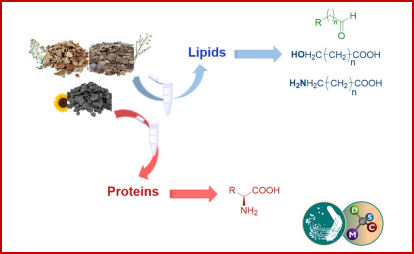
 Congratulations to our PhD student Edoardo Cignoni for his perspective entitled "The atomistic modeling of light-harvesting complexes from the physical models to the computational protocol" published in the Journal of Chemical Physics. The function of light-harvesting complexes is determined by a complex network of dynamic interactions among all the different components: the aggregate of pigments, the protein, and the surrounding environment.
Congratulations to our PhD student Edoardo Cignoni for his perspective entitled "The atomistic modeling of light-harvesting complexes from the physical models to the computational protocol" published in the Journal of Chemical Physics. The function of light-harvesting complexes is determined by a complex network of dynamic interactions among all the different components: the aggregate of pigments, the protein, and the surrounding environment.
 Congratulations to our Ph.D. students Elisabetta Rosadoni and Cosimo Micheletti and to our grant holder Francesco Ventura for their scientific publication entitled “Y-shaped alkynylimidazoles as effective push-pull fluorescent dyes for luminescent solar concentrators (LSCs)” in the Dyes and Pigments journal. Through a sustainable synthetic process involving the activation of two C–H bonds for building a Csp2-Csp bond different 2-arylalkynyl-4,5-diarylimidazoles have been prepared.
Congratulations to our Ph.D. students Elisabetta Rosadoni and Cosimo Micheletti and to our grant holder Francesco Ventura for their scientific publication entitled “Y-shaped alkynylimidazoles as effective push-pull fluorescent dyes for luminescent solar concentrators (LSCs)” in the Dyes and Pigments journal. Through a sustainable synthetic process involving the activation of two C–H bonds for building a Csp2-Csp bond different 2-arylalkynyl-4,5-diarylimidazoles have been prepared.
 Congratulations to our Ph.D. student Simona Braccini for her review article entitled “Polymeric Hydrogels for In Vitro 3D Ovarian Cancer Modeling” in the journal “International Journal of Molecular Sciences”. Ovarian cancer (OC) grows and interacts constantly with a complex microenvironment, in which immune cells, fibroblasts, blood vessels, signal molecules and the extracellular matrix coexist. This heterogeneous environment provides structural and biochemical support to the surrounding cells and undergoes constant and dynamic remodeling that actively promotes tumor initiation, progression, and metastasis.
Congratulations to our Ph.D. student Simona Braccini for her review article entitled “Polymeric Hydrogels for In Vitro 3D Ovarian Cancer Modeling” in the journal “International Journal of Molecular Sciences”. Ovarian cancer (OC) grows and interacts constantly with a complex microenvironment, in which immune cells, fibroblasts, blood vessels, signal molecules and the extracellular matrix coexist. This heterogeneous environment provides structural and biochemical support to the surrounding cells and undergoes constant and dynamic remodeling that actively promotes tumor initiation, progression, and metastasis.
 Lipasi e proteasi in un innovativo bioprocesso per la valorizzazione dei panelli di scarto dell’industria olearia. Terzo appuntamento con il nuovo progetto DSCM di comunicazione della scienza nato dalla collaborazione con Microbiologia Italia. L’articolo divulgativo del mese di marzo è stato realizzato dalla Dott.ssa Elisabetta Parodi e curato dal Dott. Nicola Di Fidio. “La biocatalisi, ossia la catalisi di reazioni chimiche da parte di cellule o enzimi, è oggi una tecnica consolidata per la sintesi organica, sia nella ricerca accademica sia nell’industria.
Lipasi e proteasi in un innovativo bioprocesso per la valorizzazione dei panelli di scarto dell’industria olearia. Terzo appuntamento con il nuovo progetto DSCM di comunicazione della scienza nato dalla collaborazione con Microbiologia Italia. L’articolo divulgativo del mese di marzo è stato realizzato dalla Dott.ssa Elisabetta Parodi e curato dal Dott. Nicola Di Fidio. “La biocatalisi, ossia la catalisi di reazioni chimiche da parte di cellule o enzimi, è oggi una tecnica consolidata per la sintesi organica, sia nella ricerca accademica sia nell’industria.



